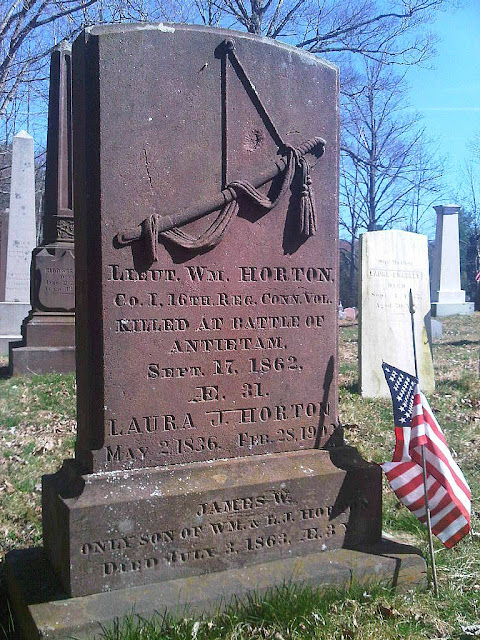 |
| Slain at Antietam, 16th Conenecticut lieutenant William Horton is buried in Stafford Street Cemetery, a rural burial ground in Stafford, Conn. |
Ide's 27-year-old brother, George, a private in the 2nd Massachusetts, was killed at Cedar Mountain in Virginia nearly two months earlier, so the pastor knew first-hand of the high cost and horror of the Civil War.
 |
| In his funeral sermon for Horton on Oct. 8, 1862, Reverend A.W. Ide said the 31-year-old soldier defended himself "most valiantly" at Antietam. |
"A nation should mourn for its slain in view of the fact that the cause of patriotism is a holy cause," Ide said on Oct. 8, 1862. "Human governments are institutions of God. The powers that be are ordained by God. Whosoever resisteth the power, resisteth the ordinance of God."
Not until more than midway through the long sermon did Ide mention the dead soldier by name: William Horton, a lieutenant in Company I of the 16th Connecticut, who was killed at Antietam 22 days earlier. The 31-year-old man left behind a wife, Laura, and three young children: Estella, 6; Hattie, 5; and James, 2.
Ide read letters from Horton's comrades at Antietam, one noting a heroic last stand by the lieutenant during the battle, the soldier "defending himself most valiantly."
"At least two of the foe fell by the well directed blows from (his) sword," Ide said, "which Stafford Boys saw fit to present to him at Hartford, before leaving the camp, and which he pledged to use in our defence, and never to dishonor..."
"We have the pleasure, my friends," Ide said later in his sermon, "to record that as a soldier, Lieutenant Horton died as every soldier should die, fighting with telling effect to the last, deeply lamented by his men. For this last act of his life, his memory demands our respect, admiration and praise. For kindness to his subordinates, and courage even to the cannon's mouth, Stafford invites the country to consider the model she has laid upon freedom's altar."
 |
| A rare copy of the sermon Reverend A.W. Ide gave at William Horton's funeral service. (Pequot Library in Southport, Conn.) |
In their first battle of the Civil War, most of the men were simply scared out of their minds. The regiment lost at least 43 killed and 161 wounded.
"One thing I can tell you is there was some pretty tall running in the 16th," Private William Drake of Company B wrote his cousin 12 days after the battle, "and I guess that I made myself scarce rather fast." (2)
Killed during the chaotic fight, Horton was buried on the field next to 16th Connecticut captains John Drake and Samuel Brown. Regiment adjutant John Burnham carefully marked the position of each man's grave ("just back of the right of the other on the north side of the tree") and placed a small headboard with each officer's name and company carved in it. (3)
William Horton's body was retreived from the battlefield and returned to Connecticut, perhaps by his family or a man employed in this horrific business. For Laura Horton, life as a widow with three young chiildren was undoubtedly a bleak prospect.
Late in his sermon, Reverend Ide addressed the 27-year-old woman.
 |
| 16th Connecticut monument at Antietam. The regiment suffered at least 43 killed during the battle. |
"Carry your bleeding heart to him: He will heal it."
Nearly 10 months after her husband was slain, Laura Horton faced even more heartache. The Horton's young son, James, died on July 3, 1863. The boy is buried in rural Stafford Street Cemetery in Stafford, not far from the center of the farming community and just a few feet from his father who was killed at Antietam.
(1) "Sermon Preached Oct. 8, 1862, at Stafford Springs, at the Funeral of Lieut. William Horton of Co. I, 16th Conn. Regt. Volunteeers, Who Was Killed at the Battle of Antietam, Sept. 17, 1862," A.W. Ide
(2) Connecticut Historical Society Civil War Manuscripts Project
(3) Hartford Courant, Sept. 30, 1862, Page 2
 |
| The Horton family in the 1860 U.S. census. William left behind a wife and three young children. His son, James, died on July 3, 1863. |
MORE ON ANTIETAM: Read my extensive thread on the battle.

No comments:
Post a Comment